Resolving Tension in Horses
To Listen or To Lead?
When tension arises in a horse we're working with, the way we react is pivotal to whether or not it is resolved and whether training can progress in relaxation and trust.
Djinnie, my 6 yo Hanoverian was quite well established in her lunging work before I had to give her rather extended time off due to having a baby. I don’t regret the delay in backing her though as she has matured beautifully during this time.
Now that I finally have time to work her regularly again, the main challenge has been resolving the tension that often arises in her during the session.
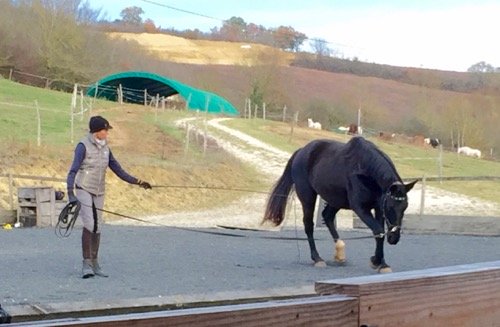
When she’s relaxed she works beautifully, with a steady longitudinal stretch, nice bend and a steady balanced rhythm.
But when she becomes tense she reverts to a hollow posture with head high an back dropped, and she falls in on the circle and loses the bend. It becomes very difficult to keep the contact, and she wants to speed up and nap towards the gate.
Sometimes her tension is triggered by something obvious, like noisy machinery nearby or the herd creating a distraction, but often she is excitable and tense for no apparent reason, just the fact that I’ve taken her from her friends and I’m inevitably making some demands on her.
It’s hard to know exactly why Djinnie should have tension associated with the arena considering that I’ve brought her on in an extremely gentle, listening way. I have always allowed her to do ‘threat assessment’ as much as she needs to. She also has a fully holistic lifestyle living 24/7 in a herd environment.
Perhaps the parting of Camille’s half of the herd last year, especially her close companion Quaramba, may have unsettled her somewhat emotionally, but she did always have a tendency towards tension before this nonetheless.
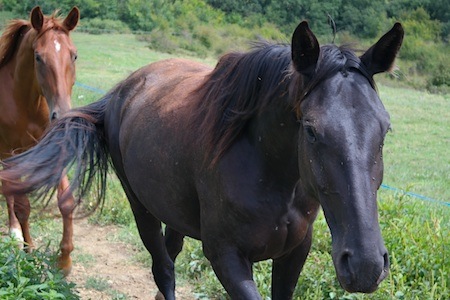
We bought Djinnie and Quaramba from the same stud at 9 months of age, and they were like sisters growing up together in the herd.
My feeling is that it’s partly just in Djinnie's nature to be highly spirited. She’s also quite a dominant, strong-willed mare, so following my requests doesn’t come very easily to her!
Horses who have grown up in a herd environment with strong bonds between each other, and who have not had their natural instincts switched off do take more time to feel relaxed about coming away from the herd in their early training. So this is clearly a factor too.
Trainable, or Forceable?
People talk about ‘trainability’ a lot with warmbloods, its one of the criteria that German warmbloods are scored on in performance testing, and Djinnie’s lines leave nothing to desire in that department.
However I actually think that modern warmbloods are bred to have a temperament that very easily gives over to tension, as this is, unfortunately, a desirable quality in competition, especially in dressage. Its seems like they are set up to be forced into the mold of so-called ’submission’ without becoming ‘dull’.
The fact is that horses who are naturally calm and cooperative do not have this ’sparkle’ that people want, yet more dominant, independent and high-spirited horses are more difficult to train. Perhaps this is one of the reasons that training methods have become increasingly forceful as sports horse breeding has developed over the last 50 years.
It reminds me of a conversation I overheard at the TTT trust once regarding bringing on a young horse. The conclusion was that it is imperative to start dressage warmbloods when they are still real babies as otherwise they get too strong and wilful and they can’t be dominated so easily!
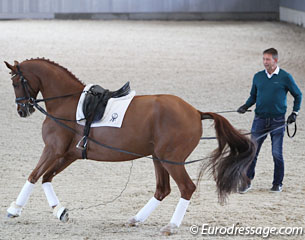
An example of hideously short side-reins forcing a young horse into a totally false frame. I'm sad to say that this is Franke Sloothaak, a showjumper who's riding technique we used to admire as kids.
Correct gymnastic training can only take place on the basis of trust and relaxation, the horse has to offer you the connection with their body voluntarily. This attitude of domination and control therefore has no place, and there is no question that I would ever use force in Djinnie’s training.
So I am happy to take the time to work through this challenge with patience and calm until she feels absolutely relaxed about her work at the arena. It’s essential to get to this stage before I start riding her so that we can both feel at ease.
Sometimes regularity has its advantages!
I’m not a big fan of the attitude, common in dressage, that horses must be worked day-in, day-out. I prefer quality over quantity, and I know that when a horse is truly engaging posturally they don’t need to work every day or have long sessions in order to make optimal progress.
However I sensed with Djinnie that at this stage she really needs to have very regular (but short) sessions to start assimilating our interactions in the arena into her daily life, instead of seeing them as something out of the ordinary that switches her onto danger-alert mode.
So I have been working her every day of the week (5 days out of 7) since the summer visitor season finished and I have the time for this. It has definitely given me more middle ground of trust with her. Her tension still comes up pretty regularly, but it does not escalate in the same way as before.
This has given me the space to become more aware of my own focus and how it influences her. and that’s what I really wanted to talk about in this article.
It raises a question that we’ve explored a lot in HHT newsletters and articles, as it’s something that underpins respectful non-forceful training: when to listen to the horse, back off from demands and give them space, and when to take up the leader role?
Until recently I would have said the answer was simple: whenever the horse expresses any kind of tension with the desire to focus their attention on the environment, we must back off and allow them to do so until they are ready to bring their attention back to us. Whenever they are relaxed and receptive we can embrace the leader role and make the (respectful) requests that are part of the gymnastic training process.
I had been sticking to this approach with Djinnie. Her tension is invariably focused on the surroundings, so I would spend a lot of time backing off and letting her do ‘threat assessment’.
I always take the time at the beginning of the session to have a ‘listening period’: taking her slowly around the arena, just being very present and relaxed with her, allowing her to look at the surroundings as much as she wants.
This allows her to relax really nicely, but when we start lunging work the tension often wells up again and she stops being receptive to me.
What I have noticed recently is that instead of backing off when this happens, if I keep my attention and intention absolutely focused on her body, her movement, the gymnastic quality of her biomechanics, keeping the energetic connection that allows me to feel her body almost as if it were my own, then her tension drops and she becomes able to relax into her work again. If I can re-establish the connection in this way she becomes receptive to me again instead of shutting me out and remaining tense.
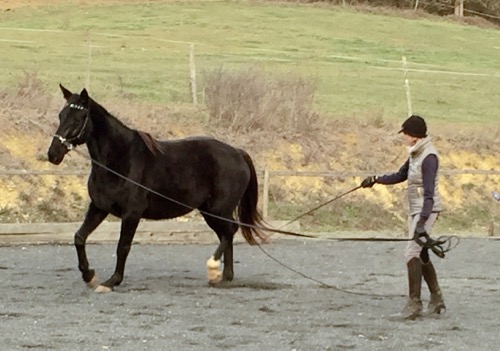
Above: A hollow posture due to tension interrupting our connection. We've lost the bend, the contact and the hindleg engagement.
Below: Half a circle later, and through keeping my focus on her balance and straightness, on the energy of her body and movement, we've reestablished our connection and found a correct engaged posture again.
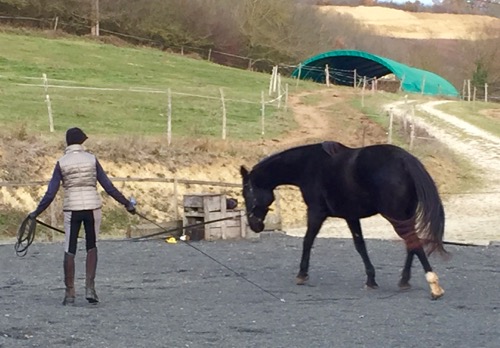
The more I explore this approach, the better I realise that when I am asking her to work on the lunge - that is to move, to listen to me - she really needs me to embrace the leader role and be a strong channeling guide for her with my mental focus and the manifestation of this in my aiding.
If she gets tense during lunging work and I back off from her, even on the most subtle level of my intention, it’s like I’m abandoning her, and her tension increases instead of diminishing.
Perhaps its natural that horses bred to endure forceful training (e.g. spurs and double bridles, short side-reins, draw-reins and other ‘gadgets’) are inevitably set up to require more affirmative guidance.
Correct gymnastic training makes it possible to give this guidance in an absolutely respectful and non-forceful way, using the sensitive channeling aiding of the contact and the carefully timed whip aids.
The real magic of this connection is in the tuning of your perception into the horse’s very being. That’s what allows you to sense the true balance of the movement and guide the horse towards that.
Fear-based Thoughts Creep In...
I am totally familiar with this way of focusing on the energy of the movement when I’m working with horses - it’s the whole basis of my approach to training and riding in fact. So I was asking myself - why did I start backing off so much with Djinnie and losing my focus on the connection?
I realised that it’s partly because I have more emotional investment related to her training than with the other horses. She is the first truly ‘bred for dressage’ horse that I’ve brought on that has not had some problems, issues or difficult background. That means that there’s more pressure to do everything just right with her.
These kind of concerns tend to take us out of the present moment and away from the intuition that really guides us to do what is ‘right’ in each moment and situation.
Concern is really a fear-based emotion, and fear always makes us go in the wrong direction!
For comparison, Vestale is another young mare in schooling work with a very similar temperament to Djinnie’s, and she can become tense very easily too.
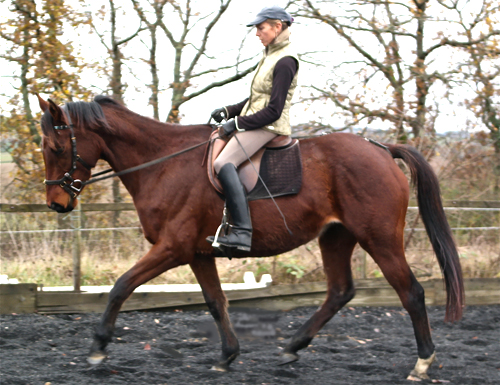
Vestale a few years back - she's muscled up a lot now but I don't have any recent photos!
In her early training she had been pushed with strong riding before there was any real basis of trust. To help resolve this I went through a stage when I first started working with her of doing a lot of listening work, backing of demands and just letting her assimilate her environment. This really allowed her to relax and start trusting me, and she let go of some extremely tense, spooky behaviour in the arena.
At
the same time, she is, like Djinnie, a dominant and strong-willed mare,
and she definitely needs a confident, positive leader.
It was when I was thinking about how Djinnie needs a strong guidance that I realised this is what I do, intuitively, with Vestale when I’m riding her and she has any kind of tension come up. Unless I sense she needs to assess something particular in the surroundings (in which case I always give her time to stop and look) I keep my aiding and my focus on the work very steady and present, not backing off. This consolidates our connection and allows her to relax into the security it gives her.
The Truth is in the Boundary
This really all comes back to the idea of boundaries, a concept you’ll be familiar with if you’ve followed the HHT approach.
Traumatised horses who have lost their trust in people have damaged boundaries because their sense of the integrity of their own being has been disturbed, and they are no longer confident and comfortable with the interaction of a normal relationship. These horses need a lot of space to heal their boundaries, and you have to learn to back off before the trauma response is triggered.
Working with horses like this regularly is, I think, the other reason that I was backing off with Djinnie. Horses like her who have never been forced have a naturally healthy boundary, and the dominant mare personality makes it even stronger. If we want to make the kind of interactive connection involved on gymnastic training, then we must meet this strong boundary, resonating with its energy, in order to gel with it. Only then can we become part of the horse enough to channel their energy in motion.
Concern for being too assertive in your training method is certainly better than going towards the other extreme of being forceful, but it’s still an essentially fear-based concept of the intellectual mind. It gets in the way of our awareness of what is energetically ‘right’ in each moment.
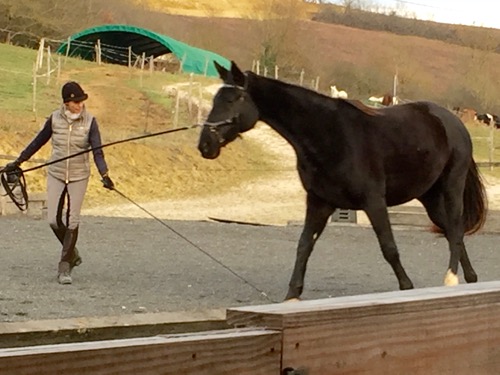
Another example of keeping the focus and the channeling in place in a moment of distraction to resolve the tension and come back to the engaged posture.
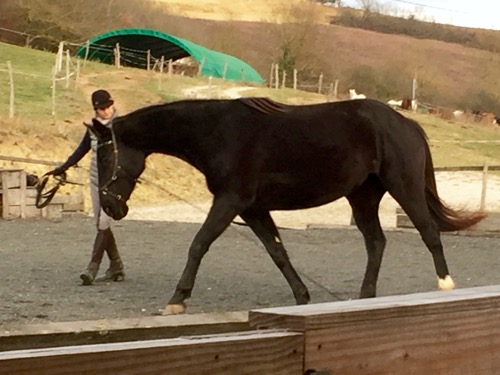
The essential part is to realise that meeting with the boundary has nothing in common with pushing through it in the way that force does. It requires a totally different state of mind: one of calm, patience, centeredness and acceptance.
If we react to a horse’s tension with our ego and succumb to impatience, frustration or anger, then we will almost certainly end up pushing through boundaries and betraying the horse’s trust.
Meeting with the boundary is really a way
of listening to the horse in a profound way, on a
physical-energetic-biomechanical level. It’s very much like focusing
your awareness on your body, often on breathing, in meditation in order
to come out of thoughts and into the present moment.

Intuition Over Rules
This learning process with Djinnie has taught me, once again, that it’s impossible to bring our relationship with horses down to rules, no matter how evolved or sophisticated they may be.
Nothing is ever black and white.
Knowing how to react to difficult situations is all about listening to your intuition and keeping recognising when intellectual thoughts get in the way of that, even when they come in the form of too much questioning and doubting ourselves and fear of doing the wrong thing.
That’s why it’s impossible to say that you should always react to tension in such and such a way. Each horse is an individual and each moment is dynamic. These are the conclusions I have drawn from my own experience so far though:
When the horse goes into a stress response due to a perceived threat in the environment, it’s vital to listen to that and respect the horse’s essential prey nature by backing off and allowing the threat-assessment behaviour.
But when tension manifests as more general high-spiritedness, or due to being removed from the safety of the herd, then it can be more appropriate to release it though the gymnastic connection that brings the horse’s attention back to their body, and channels their energy into harmonious balanced movement.
In this situation, if we resonate with the horse’s tension by reacting to it and backing off the gymnastic connection, then the horse may stay stuck in their prey response and tension will remain or grow until the horse regains the security of the herd (or whatever replaces that safety).
If, on the other hand, we can temporarily become the horse’s herd while we are working with them, though the security, grounding and pleasure that our guidance offers, then we can help the horse transcend the prey response and enjoy the liberation of being in the now.
Then listening and leading become one.
The pages on HHT are so wide-ranging and interrelated that we strongly recommend you look at the site plan to find other subjects that may interest you.
New from HHT!
AudioRide is a series of exercises designed to listen to while you ride.
Audio descriptions guide you through each step of developing a balanced, dynamic connection with the horse through your position.
This truly innovative learning tool gives you a whole new way of being guided in your riding, in a calm, clear, step-by-step way.
Free Download! Introductory Exercise: Riding in the Now
The Gymnastic Rider eBook
Now available exclusively from HHT!
A unique, comprehensive guide to practical rider biomechanics. This professionally produced eBook takes the rider through the process of developing their body in the specific way that brings the horse's movement into harmony and balance, without force and constraint. Click here for full details, and to download the 15-page introduction to the book for free.
Join the Happy Horse Training group on Facebook!
See and share topical info, news and photo's, and take part in lively discussions.
Click here to go to the HHT group (make sure you log into fb first) and then click on the 'join' button at the top of the page.
Join the Whole Horse Newsletter!
HHT's free monthly newsletter giving you wide-ranging and intelligent insights into holistic horsemanship.
Just enter your details below to join.
Free bonus on the riding position with all new subscriptions: Ten Top Tips To Instantly Improve Your Connection With Your Horse.
Click here to see back issues of The Whole Horse newsletter
Train Your Horse
The Holistic Way
How To Train A Horse Without Force
is a unique guide to training horses through energetic connection and
gymnastic training. Part 1 covers everything on the ground, from
handling to the lungeing technique that develops strength, straightness
and engagement. Comes with a free eBook supplement on Horse Trauma.
Click here for more details.
"As a student of Zen Buddhism for nearly three decades, I've often wondered when someone was going to write the book on Zen and the art of horsemanship, and I think that your emphasis on mindfulness and energy connection gets right at the heart of the matter."
- Prof. Teresa Lloyd, U.S.
Do You Have
A Horse Story
To Share On HHT?
So many people have been through
wonderful experiences with horses, whether in training or otherwise. If
you've made a change in a horse's life - or one has made a change in
yours - tell us about it here.
Learn The Natural Barefoot Trim - The Simple Way
The Simple Seven-Step Natural Trim is a comprehensive step-by-step guide to a cutting-edge barefoot trim. Click here to find out more.
What people say about HHT:
"The riding instruction is outstanding, if instructors in the UK taught this way there would be a lot of happy riders and horses."
"The riding tuition exceeded my hopes and expectations by a long way; giving me an exciting new facet to horsemanship which is lighter. more subtle, more elegant and more meaningful. It is as if a new door has opened bringing more sunlight and air."
"My goodness - what a change has taken place in my riding. I think that I'm starting to sit 'into' the horse rather than on top of him. I felt my horse's movements in a way that has almost never happened before"
Click on Testimonials for more





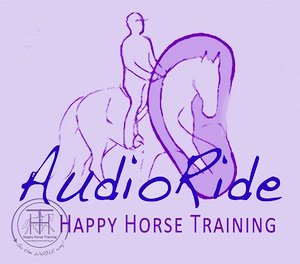




New! Comments
Anything to say about this page? Leave your comment in the box below.